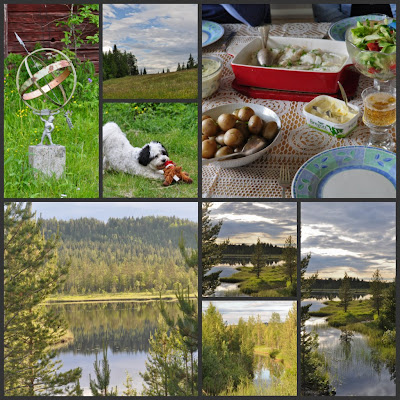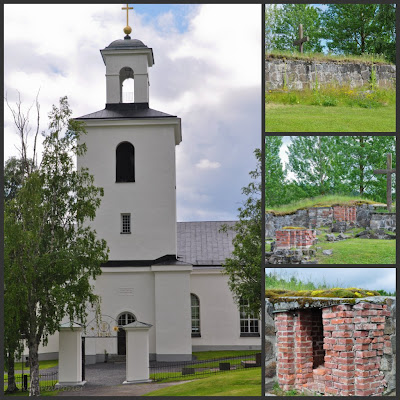 | Before leaving Lycksele, I took a photo of the Hotell Duvan where we stayed two nights in Lycksele and several interior views of Lycksele kyrka (across the street and in the collage below). |

Built of wood from 1795-1799, the interior of Lycksele kyrka was painted to resemble marble (lower left) and ceiling paintings were added in the 1950s during a restoration. The fabulous organ was added in 1977 during a more recent renovation. The front altar painting by CG Sjöstrand (lower right) depicts the resurrection of Christ and was added in 1842. The fabulously gilded high pulpit is one of many such high pulpits present in churches all over Sweden. While researching Lycksele kyrka on the internet, I found an interesting Google translation from the Swedish Wikipedia article on Lycksele kyrka: "The church is built of sleeping hours and consists of nave with cows in the east and the west tower." I have NO IDEA what that means but think I'd prefer my church without cows! I can relate to "sleeping hours" in church though… ;-)

En route to Tärnaby from Lycksele, we were treated to a stop at a roadside picnic area alongside the Umeälven, Ume River, marked by the red dot on the map shown between the two river views. Seated on the left of the picnic table from front to back are myself, my sister Valerie and my brother Lukas; on the right (same order), cousin-in-law Inger, my brother's partner Tom and cousin Sture. As usual, we were treated to a fine snack and freshly brewed coffee! The wooden "box" houses trash cans and keeps the four-legged critters from the garbage. The church is Stensele kyrka... anxious to reach Tärnaby, we did not stop to explore this largest wooden church in Sweden. (we did make a short side trip to visit this church two days later)

First order of business on arrival... light a fire to dispel the chill from the air... it's cool even in summer in the mountains! As soon as the cars were unpacked we set the table and Inger began preparing food for our afternoon meal... Another lovely meal with appetizers of herring two ways (one in cream sauce with egg and onions and one pickled), more potatoes, some riced to have with the main meal and some whole as an option to have with the herring. The main meal was moose with chanterelles and gravy (absolutely delicious), riced potatoes, rye toast, lingonberry jam and salad followed by a dessert of homemade rhubarb pie warm from the oven served with a vanilla cream sauce.The downstairs rooms have dual purpose "couches" that doubled as sleeping space for Sture and Inger during our stay. They insisted we sleep in the upstairs rooms.

Upstairs, the smaller of the two bedrooms is colorfully decorated and furnished with two twin beds, the larger of the two (lower right) has two twin beds and a sleep sofa that can be expanded for additional sleeping space. And if that isn't enough, there is a small "cottage" opposite the main house that sleeps more (upper right). Sture and Inger lived in this one-room cottage during the construction of their larger home. They built it themselves using, in part, materials from an old house Sture bought and had transported to their property in Tärnaby in order to take it apart and use the materials in construction of their vacation home. The wedding photo sits on the table (a small part of which is seen in the foreground, lower right) and is of their older son Örjan and his wife Lisa. I rather like the look the glare on the glass gave this photo of a photo.

What to do after our marvelous meal? Why, walk it off, of course. Through the forest and down to Lake Gäutan where we saw the sunlight on Ryfjället, the lower of the two main peaks seen here, and spotted quite a few alpine flowers along the way (or on a later walk). Ryfjället rises 1130 meters (0.7 miles) above sea level; the taller and more distant peak is Ryivegaise which rises 1412 meters (0.87 miles) above sea level.

Another look at Ryfjället and Lake Gäutan, Sture, Inger and Frosse (phonetic spelling) on the lake shore, the colorful door to their home with its lovely hardware and the moose antlers seen on a neighbor's garage. One note about hiking down to Lake Gäutan... if you ever find yourself in Sweden hiking around this lake, make sure you have used a good insect repellant! The mosquitoes were pretty hungry.

This is a bit out of order since this image is from Vägsele but I wanted to include it anyway. The home seen here belonged to Sture's parents. The small extension on the right of the main house was used as a post office until 1960; during that time, Sture's mother was postmistress for the town of Vägsele. The main house dates from the 1930s but both the post office extension and the porch on the left were added at later dates.










































